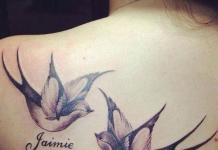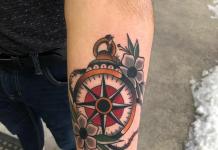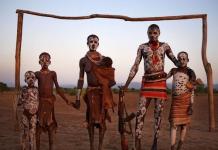We are somehow used to the fact that a hike is a heavy or very heavy backpack, tired legs bogged down in moss, lush grass, river silt or sand, a test of endurance and will. And going out into the forest without everything you need is not even serious ... But there is even a direction in tourism - ease of movement, where the main condition is the minimum weight of equipment, due to which high speed is achieved, and along with this, an impressive stamina allows you to go oh how far. But it’s not easy to be a light mover – you need to compensate for the minimum equipment with your skills and abilities. In fact, the so-called "survival trip", when there is only one in your pocket - and there is ease of movement.
But first things first. To walk light, admire nature and enjoy long routes, you need to know…
100 easy rules
001. To get started, buy a small digital scale or a digital steelyard. A load capacity of up to 10 kg is quite suitable. Now you can safely take your precision instrument to the store and weigh what you buy. Do not be afraid to scare the sellers, and don't let them scare you anymore, now everything is under control!
002. The most reliable and affordable way to lose equipment weight is. It is not at all difficult to lose a few kilograms, and the lightness and endurance that you gain is irreplaceable!
Brief historical background: the word "light-moving" or "light-moving tourism" comes from the American lightweight backpacking (or ultralight backbacking), that is, traveling with a light backpack. The desire to reduce the weight of the backpack massively spread in the United States in the mid-90s. The impetus for the "change of mind" of many hikers was Ray Jardine's "Pacific Crest Trail Hikers Handbook" (1996). along the Pacific coast from the Mexican to the Canadian border with a total length of more than 4000 km). In his book, Ray described his personal experience of quickly climbing the trail with a daily mileage of about 48 km and using home-made light equipment. The book was republished in 1999 under the title Beyond Backpacking (the title can be translated as "Tourism in a different way") - .
So, "historically", light walkers are those who overcome long distances fast thanks to the selection light equipment. In other words, ease of movement has a specific goal - to complete the route in the shortest possible time.
In fact, in our Russian-speaking environment, everyone who seeks to lighten their backpack is called easy-going, regardless of the “walking style” - whether it is a family PVD in the Moscow region or a serious mountain route in the Fann Mountains. Light walkers are often confused with survivalists and vice versa, because it seems that the lighter the backpack and the fewer things, the better, and the ideal is to go into the forest with one knife in your mouth :) But we still have tourism, route and destinations, and not proving to yourself and others that you can live without equipment :)
The most "light-moving" event we have now is, perhaps, forced marches and rogaines. Everything is present there: there is a multi-kilometer route of about 100 km and there is a goal - to go as quickly as possible, meeting the allotted time.
My light tourism:
I became interested in light tourism in 2012. I have always been haunted by the question why backpacks in PVD are almost the same size as in two-week trips. "It's all about the backpack itself" - I decided and sewed myself a light backpack. Then off we go ... Tent, sleeping bag ... Heavy items are replaced by light ones, there are fewer and fewer "spare" clothes...
I began to study the topic more seriously when I was preparing for a "big" autonomous trip to the Polar Urals. Without all these ideas of lightness, we would hardly have passed it together.
I like to experiment with light gear and light backpacks. I’m going on short trips much faster, I can always blow myself up in at least half an hour, because there are few things and they are very simple - shelter, sleeping bag, kitchen, first aid kit, warm clothes. And I get much more pleasure from walking with a light backpack.
For me, "easy-going" is, first of all, the rejection of generally accepted tourist stereotypes and marketing slogans that the tent must necessarily be an arc two-layer hemisphere (the main thing is more mm of water column on the awning and the bottom! and in general, suddenly a hurricane will fly in the suburbs) , a backpack - with an "anatomical back" (3-kilogram Tatonki are the best backpacks in the world! with them you will carry your 30 kg of equipment like a feather and your back will tell you "thank you!"), Mat - Izhevka (inflatable rugs are all bourgeois and they are sure to break!), KLMN steel (never breaks! you can boil water in a mug if you lose your bowler hat!), boots - "ankle support" and "vibram sole" (the best grip on wet stones! you will never don't twist your leg!) etc. etc.
Light tourism has a different approach: here minimalism and simplicity must be combined with experience and tourist skills. This is not about lack of comfort or safety. On the contrary, comfort is achieved with conscious minimal effort.
Lightweight is not the one who was able to assemble the lightest backpack.
And the one who competently collected equipment for a specific trip, taking into account his experience, skills and goals of the trip itself.
light tourism is skills and experience. Properly picking up equipment and then using it is also a skill and experience. Example: in a mountainous area, where the owner of a "reliable" tent can put his shelter almost anywhere, relying on the reliability (including due to weight) of the structure, a light walker with an awning will simply look for a less windy and safer place, and the result one is a quiet overnight stay.
But, if you have already embarked on the path of relief by buying a sacred object - electronic scales - there will be no turning back :) The main thing is without fanaticism and turning off your head.
How to reduce the weight of a backpack
Ways to reduce the weight of a backpack have long been known and described on many sites - giving up excess equipment (towels, five spare T-shirts, shampoo bottles, etc.), choosing light and multifunctional items of equipment instead of used ones that are too heavy (for example, plastic dishes are lighter than metal ones). about 4 times). It is best to start (although the most expensive too) with the "big three" - shelter, backpack and sleeping bag. As the lightest shelter for one person, I came up with a set of tent + bivouac bag (short summer and off-season outings) weighing about 500 grams, a 40-liter backpack weighing 300 grams and a light down 600-gram sleeping bag up to -4 instead of a synthetic 850- gram to +5. This is my quite comfortable and moderately light set, which covers at least the whole summer + PVD in the off-season, until frost ....The most expensive thing here is a downy sleeping bag (but it will last much longer than synthetics). A simple light tent costs about 1500 rubles. (or), a bivouac bag made of Tyvek to order about 1000-2000 rubles (, a light backpack will cost 2500-5000 rubles. Still think that ease of movement is expensive? Calculate how much an average tent costs, how much an average universal backpack is 80-90 liters...
Some, due to insufficient knowledge of the subject, sincerely believe that light tourism is "saving on matches." How much exactly these "matches" will weigh and whether the game is worth the candle, as well as the fact that you can throw a few kilograms out of your backpack without spending any money, I tried to visually depict in this article.
And, perhaps, I will repeat the common truths that seem to be so obvious to any tourist, but for some reason are sometimes forgotten: reducing the weight of equipment, of course, should be reasonable And safe- not everywhere it is appropriate to walk with an awning, in sneakers, with a minimum of warm clothes and the like. The limits of sanity and security individual, and depend on experience, physical fitness, personal preferences, type of hike, and the like. The selection of light equipment is always determined specific campaign(type: walking, water, proud, weather, vegetation, season, etc.), personal experience and your purpose, i.e. Why are you even hiking? Go fishing? Then it would be foolish to save on the number of spinners and fishing equipment. Take a photo? 5 kilos of photographic equipment is normal.
There is no universal list of light-moving equipment suitable for any tourist and any conditions, there are no "lightest" tents, sleeping bags, backpacks, etc.
Now there are many tourists who are not engaged in tourism as a sport (where there are categories, ranks, route books, etc.), but who want to travel far / long / without a bunch of extra junk / easy.
This is my list of lightweight equipment and clothing for summer (April-October) solo hiking trips in the mountains with overnight stays above the forest line, the duration of the autonomous part is 3-10 days. Designed for day and night temperatures above zero degrees.
With some modifications, it can be adapted to more difficult or easier routes. I would like to make the backpack lighter, but everything depends on spending the night above the forest level (> 1500 m) - you need a margin of safety for bad weather and low temperatures. I like to walk without being attached to the infrastructure, therefore, I carry all the food with me. Usually, this is about 500 g per day, i.e. for a week - 3 kg (without breakfast on the first day and dinner on the last).
Purpose: Hiking solo hikes in the mountains with overnight stays above the forest level in the warm season in changeable weather with rain.
Target: lighten the backpack to go further and with a large margin of safety, less tired. The equipment is not tied to any particular route, i.e. for a specific trip, you can and should change something. If possible, the equipment should be universal so that it can be used on other trips, on mountain climbs or in the city.
Restrictions: constant day and night temperatures above zero degrees, lack of technical areas (no ice ax, crampons, rope, system, iron).
Possible changes:
- for hikes with passes 1A - an ice ax, sneakers with a hard sole, flashlights so that stones do not fall asleep.
- for lower temperatures - a quilt-condenser for a sleeping bag, warmer shoes, softshell pants instead of those indicated.
- hiking in a group - another tent and a burner with a boiler / boilers.
- for hot trips (at night temperatures above 15 degrees, daytime - above 25) do not take warm and rainy clothes, a lighter sleeping bag, a sun hat and a long-sleeved T-shirt.
- for spring hikes in the High Tatras (snow above 1200 m waist-deep in some valleys until May) - a backpack 45 l, 1114 g, with a pocket on the back, an avalanche shovel for digging places for a tent, full shoe covers for snow porridge, an ice ax, crampons, trekking boots with a membrane.
Reserves for facilitating existing things:
City fresh t-shirt and socks, ~110 g. If orientation is not difficult, you can not take GPS and spare batteries, ~280 g. If the temperature does not drop below +10 degrees, do not take a warm jacket, ~450 g. Kemelbek for 3 liters, so that you can spend the night in places without water (185 g, minus 2 l PET bottle - 135 g). If you walk along unpaved paths - lighter sneakers, ~ 300-400 g. In principle, you can take a lighter backpack by ~ 500 g.
Of course, the cheapest way to lighten the backpack is to leave unnecessary things at home. But, if everything unnecessary has already been left, you need to change what is. From this list, if you try, on a week-long hike, you can carve out about 2 kg relatively painlessly.
An example of how to carve out a kilogram from this list: a light backpack.
In this option, the dry weight of the backpack (without food, water, a minimum set of clothes, shoes and trekking poles) is 7.5 kg. With food for a week and 0.5 liters of water, you get about 11 kg.
The weight of all items in the list for size L, shoes - 45, weighed by scales with an accuracy of 1 g.
Source: http://verwandert.de/alexika/
Last year I started looking for a new tent. Timo and I used the igloo tent for a long time, which we bought in one of the cheap supermarkets during the next trip, but it was not particularly fun in it. It is clear that for one night in nature in the summer it was enough, but this tent could not stand the rain at all.
It's time to get the right gear because I got frustrated with my sleeping bag or yoga mat that I used as a camping sleeping mat.
On my next trip to Saxon Switzerland, I went with the following Alexika equipment:
Tent Super Light 2
Extreme travel mat Expert
Tent Alexika Super Light in practice
Somewhere and sometime, the assembly instructions left us, and during the first test assembly of the tent at home, I had a question: “Where do you need to stick the arcs?”
This lasted until I decided that the arcs should not be outside, but they are installed from the inside of the tent. Then she really quickly gathers, and she can really be put alone.
From the outside, the tent doesn't look big. It is clear, because it weighs only 1.45 kg and is packed as much as possible in a compact case. Inside it, however, there is enough space for two.
In general, for myself in the tent, I identified three main drawbacks:
1. If you are lying in a tent together, then there is no free space left. Even one backpack will not fit inside. This is what makes her so light.
2. The length of the tent is 2 meters. It seems big, but for tall people it is not enough. Timo could not lie in the tent, fully stretched out.
3. To set up the tent, you need to open it. Therefore, in the rain, it can get wet from the inside.
Advantages of Alexika Super Light:
1. As already mentioned, it is very light, so it is convenient to travel with it on foot.
2. It requires a minimum area for installation.
3. There are 2 entrances in the tent, which, in my opinion, is very convenient. Both doors can be opened only halfway, leaving the mosquito net closed, and then in the evenings you can enjoy the contemplation of the moon.
4. You can sit in the tent! It's very practical!
5. The workmanship is top notch.
As this is the only super lightweight tent I have ever tried, I cannot compare it to other similar tents. At the moment, this tent seems like a great choice to me, plus it's suitable for year-round use.
Alexika Expert self-inflating mat is the best choice

I already wrote in the title: I am delighted with this rug and can happily recommend it to you!
The self-inflating Expert mat weighs only 0.5 kg and packs into a very compact barrel. I even lost it a couple of times in Egon's saddlebag because it was hidden somewhere under my things.
The rug can be inflated very quickly. Despite its thickness (only 2.5 cm), it is very comfortable. All 10 nights of the trip, I slept on this rug as on a full-fledged mattress.

The rug is only 1.73 cm long, but despite this, I would recommend it for tall people as well. Feet do not have to sleep on soft!
In short: this rug deserves my highest recommendation!
Femalesleeping bagAlexika Mountain Compact

Women's sleeping bag? Is this really necessary? Every time I ask myself: why should I carry an extra 10 cm of a sleeping bag that I don’t use? I needed a sleeping bag only 1 size smaller than usual, because the Alexika Mountain Compact sleeping bag is designed for people whose height does not exceed 1.78 m.
So far, I have found the following shortcomings:
1. Before that, I used a fairly spacious sleeping bag, so I had to get used to the design of a sleeping bag-cocoon. This shape did not quite fit my legs, they did not like being squeezed in such a position.
2. The sleeping bag weighs 1.7 kg, and it is quite voluminous. I couldn't fit it into Egon's saddlebag, although that would have been ideal.

At the same time, the Alexika Mountain Compact sleeping bag also has advantages:
1. It is lovely, soft and warm. I'm a chill, and one night the temperature dropped to zero, but nevertheless, I slept comfortably!
2. The material is very pleasant to the touch.
3. The hood of the sleeping bag is very comfortable and tightens well. You can tighten it so that only the nose sticks out.

Conclusion about tested equipment
I believe that with the tent we have not yet fully understood each other. Perhaps a tent or a tent would suit me better. I'm still experimenting with this.
From now on, the self-inflating mat will now always and everywhere be with me.
I haven't decided on a sleeping bag yet. Perhaps, I will not look for an alternative sleeping bag for a long time, so that it is just as warm, but has a smaller mass. However, this sleeping bag is very comfortable and I will continue to use it with pleasure.
And what do you use from super light equipment for overnight stays in nature?
I've been hiking for 18 years now. Of these, 10 worked as an instructor for youth tourism: he led schoolchildren, students and adults on category trips. Anything happened: people took with them three kilos of sweets per face, liter bottles of shampoo and even metal trays. Based on my experience, I will tell you how to lighten the backpack so that it is less annoying in the mountains, and the hike brings more pleasure and is remembered not only by the view of the trail under your feet.
Why lighten your backpack
- More to go and more to see. A short vacation is a harsh reality, and sometimes you want to do something big: go 400 kilometers and 15 passes in 7-10 days. To do this, you need a light backpack.
Enjoy the movement. The famous American light-walker Andrew Skurka (walked 11,000 km in one season) has a scale with two concepts: trekking and camping, that is, when you go and when you sit in the camp. The longer the walking part, the lighter the backpack should be, the longer you are in the camp, the less important the weight of the backpack.
Take care of your health. If the route is long and autonomous, the weight of the backpack is especially important. On a hike for a month, you simply do not have enough strength and health to carry a heavy backpack.
Save on luggage costs. If you plan to fly with low-cost airlines or just fly a lot, each time putting a 23-kilogram backpack on the loader belt, you will have to overpay 30-50 dollars per flight. The same thing happens if you find a last minute trip or a very cheap flight where there is no luggage. With a light backpack, groceries can be bought on the spot, and all equipment fits into the norm for hand luggage.
Combine trekking/climbing with free travel. For example, when traveling in Asia, you can go from Cambodia to Thailand, then to Malaysia and go on two 3-day jungle trekking along the way. On these trips, a light backpack is essential.
Get used to the mountains faster. A person who first got into the mountains with comfort will want to return. My first trip was with a backpack of 120 liters, a sleeping bag weighing almost three kilos, and as insulation I took with me a construction one-piece overalls and a knitted sweater with deer. In addition, I also carried a 12-liter bowler hat for a team of 48 people. All this weighed more than 20 kilograms. It was harsh and hard, but I liked it and I still go. However, for many people, such a trip may be the last.
- Make room for amenities. On weekend hikes, my backpack, along with food, weighs no more than 6 kilograms. Walking is easy, so on top of that I take a folding chair with me. It weighs 450 grams and I can afford them. If you get confused, you can reduce the weight of the backpack to 3.5 kilograms, but at the same time take a pillow or other comforts with you. In the photographs of many light walkers from the USA from the Apalachian Trail, you can see girls with their favorite teddy bear or a bearded uncle with a Hellinox folding chair, but at the same time a 30-liter backpack. A friend of mine counts the mass of equipment in sneakers: sawed off the handle of a toothbrush, took shorter socks - you can take one extra snickers and so on.
Go to the mountains at any age. Those who are 7 and 70 years old have a common problem: neither one nor the other can carry much and go quickly under a heavy backpack. Schoolchildren are especially “lucky”: parents like to add another 5-6 kilograms to the total weight of the backpack in the form of sweets, extra clothes, dishes and something else “just in case”. For example, one compassionate mother gave the boy an aluminum tray for hot on the train - the poor fellow wore it the entire route.
If your teenage child has already been on a hike, he probably knows what should be in a backpack. Therefore, do not burden him with unnecessary things and try not to interfere.
What is the weight of the backpack
Personal equipment
This is everything you personally need: a backpack, a sleeping bag, a mat, clothes, shoes, dishes and personal iron. The heaviest thing is a backpack and a sleeping system (sleeping bag and mat). Personal equipment makes up more than half the weight of a backpack, so lighten it first.

public equipment
- Tent. Oddly enough, not every hike needs a tent: somewhere you can get by with one awning or a hammock and an awning. Not everywhere there are glaciers, low temperatures, hurricane winds, or, conversely, mosquitoes, heat, and so on. In areas with good infrastructure, you can spend the night in shelters or rent tents - that is, do not carry shelter at all. In this style, for example, goes the famous Alpine route Alta Via.
- group utensils. We have a tradition in our country - to go hiking with a large team. And the more people, the more voluminous the dishes, and often its useful volume is twice the required one. At student gatherings, you can see cans with a volume of 6-12 liters. On the one hand, this optimizes the amount of equipment, and on the other hand, it greatly increases its weight. If we take volumetric dishes, then from light materials: thin steel sheet, aluminum, titanium.
Burners and cooking systems. In the mountains, a burner is almost always needed, with the exception of the forest-tundra or subalpine terrain, where you can use a wood chip stove. If this is not a winter hike where you need to take a heavy oil burner, choose something lighter.
- first aid kit. A camping classic is when the size of the first aid kit approaches the size of an ambulance first aid kit. But if there is no real doctor in the group who is able to use all this, it is practically useless. Collect a group first aid kit only from those drugs that you really know how to use. For example, if no one in the group knows how to give injections, you do not need to take ampoules. Plus, part of the first-aid kit can be made personal: give everyone a bandage, plaster, vitamin C plate, antipyretic, etc.
Group climbing equipment. These are ropes, hooks, bookmarks, drills, station loops, extractors, hammers and more. It is often impossible to reduce the amount of iron because it will increase the level of danger or require more training and skills from you.

Consumables
This is all that will leave your backpack as you move:
- Food. It is consumed the fastest, so saving only makes sense on long routes. High-calorie foods (lard, chocolate, etc.) and sublimates help to save weight.
Fuel. In the mountains there is often nothing to burn, so you have to carry fuel with you. In 90% of cases it is gas, less often - liquid fuel. The best liquid fuel is Kalosh gasoline, in the mountains it works even better than vaunted aviation gasoline. There was a case when aviation kerosene did not burn at a height: with the vestibule open, the tent burns, and with the closed one, it immediately goes out. But it must work at an altitude of 12,000 meters.
Sun cream. In the mountains, they need to be smeared intensively and greasy, otherwise they can burn out more than in the tropics. To save on its weight, you can take one tube for 2-3 people or use a more concentrated cream with the highest protection factor - you need less of it.
Soap, paper, personal care products. All this is consumed quickly, although more slowly than food. Ordinary soap can be replaced with light sheet soap, shampoo can be taken only in probes or bags, but it’s better not to save on toilet paper. I know a team that calculated toilet paper in squares, and then they had an unexpected "miner", and they are in alpine meadows with only these squares ... It didn't work out well.
Expendable loops, hooks, embedded elements, etc.. Everything that you leave at the pass or at the top when you arrange belay. Even expensive friends are sometimes left if they cannot take them out or there is nothing else to make a station on. Saving on weight at the expense of consumables is also not worth it, but it is worthwhile to study in advance the descriptions of the passes and peaks that you are going to pass. Usually the number of consumables for the rappel can be calculated as the number of ropes for the descent plus 2-3 cordalets just in case.
Why do people carry heavy backpacks?
Tourism traditions and stereotypes
Russia has a cool school of tourism and strong stereotypes. Those rules that were written back in the USSR are still in effect. For example, according to Soviet technology, the chest harness must be blocked with a rope with a diameter of 10 mm. But this requirement is mandatory only for competitions, and in the campaign you can use a lighter and equally strong sling from which station loops are sewn. Such a system becomes not only lighter, but also more comfortable in movement, which means it increases the safety of the participant when driving on difficult terrain. Blocking with a loop and a dynamic “nine” instead of a “ten” is not only acceptable, but also successfully used by many tourist clubs and climbers.
Poor knowledge of the area and conditions
Before you go to the mountains, you need to study reports in advance, read forums, ask people, go to lectures, watch videos, etc. If you know the area well, you will stop being afraid of the unknown and take unnecessary equipment with you. For example, let's take the Alakol pass on the Terskey Alatau ridge, about 4000 meters high - it seems very high and scary, but in fact local porters walk there in slippers, and Europeans - in light tracks. Severe climbing boots are useless there.
Excess "iron" in simple trips
Many tourists take zhumars, a bunch of tie ropes, expendable loops and other things on a hike of the first category of complexity, although none of the passes requires this. If the goal of training is one thing, but if there are no vertical walls and climbing in the chosen category of the hike, the extra hardware is not needed. Therefore, find out the conditions of the trip in advance. If you want to practice, organize the transfer of iron to the alpine camp, if there is one in the area.
No experience with light equipment
Have you ever spent the night under an awning in the mountains? I spent the night and I know that it is possible. However, most people find it difficult to imagine what it is like. What if it gets cold? Will it rain? It’s still blowing, probably… It’s hard to step over the psychological boundary and replace a reliable 5-kilogram tent with a light tent. But after all, such a tent is not needed everywhere, for example, in the Carpathians or Arkhyz, you can safely spend the night under an awning.

Daring brave
This quality allows you to collect more equipment, help the girl, take a liter of shampoo and several liters of water with you to wash your hair, etc. And these are not tales.
My friend once conducted an internship in the Caucasus among geography students. The guys with minimal field experience have never been in the mountains. They go slowly, it's hard and bad for everyone. A friend says: "So, that's it - we stop and unpack, let's see what you have typed with you." The first girl had a 1.5-liter bottle of shampoo with her, the second participant carried a 5-liter bottle of water to wash her hair in the middle of the day!
The desire to embrace the immensity on the route
The classic scheme: “Now the boys and I are going on a hike of the third category of difficulty, and at the end to Elbrus.” Surely you have heard this story? I only know one person who has done it. It’s not that it’s impossible to do this, but when you went to the “C grade”, for about 12-14 days, walked in the mountains, spent time on a glacier, got wet and dry, loosened up, rescue work, you had to carry something for someone, and in the end - and now we will go to Elbrus! And you already ate hychins in the Azau clearing, drank beer, washed down with narzan and you don’t feel like going anywhere. But especially for Elbrus, you carried crampons and a puff with you the entire route. Conclusion: do not deceive yourself and correctly calculate the forces.
And in order not to carry a cat and a puff with you for the whole hike, you can make a drop off: leave somewhere all the equipment that is not needed on the main part of the route, and pick it up before climbing. How to do it right, we tell in the article about abandonment.
"Young Leader Syndrome"
When a person goes camping for the first time or to a new area, he plays it safe (and rightly so): he forces the participants and himself to take excess equipment. The young leader himself bears the most. Like: I came up with it - I'll carry it.
Inability to purchase light equipment
For financial reasons or due to the fact that there are simply no normal light equipment in the sports shops of small Russian cities. Although everywhere there are usually craftsmen who sew themselves - I also did that. And the Sport-Marathon store delivers equipment to all regions of Russia and many regions of the CIS.
How to reduce the weight of a backpack

Go hiking more often
How to prepare for the mountains without being in the mountains? You have to do a lot of weekend hikes. Even if there is no way to learn how to walk on a glacier in crampons or kurumniks and scree, it will still benefit. You will feel for yourself and understand what you need on a hike, and what can be laid out or replaced with a lighter one.
Plan a route
If the route is well planned and you know exactly what awaits you, you will not need extra equipment “just in case” and supplies of food and fuel for extra days. The more predictable the route, the less "any cases".
Weigh everything
To lighten the backpack at the expense of personal and public equipment, you need to carefully weigh everything. Socks, jacket, favorite fleece, pants and even a spoon. Weigh and compare - what is easier and works better on a hike is the one to lie in a backpack.
Example 1: woolen socks with deer weigh 105 grams and primaloft chuni (socks made of modern PrimaLoft synthetic insulation) also weigh 105 grams. The weight is the same, but chunies are 5 times warmer, take up less packing volume, breathe better and warm when wet. Socks with deer are clearly a loser.


































